Abstract
With the advent of 6G technologies, satellite communication networks are in urgent need of innovative bearer technologies to meet the demands of government and enterprise private lines as well as computing power networks. We propose optical service unit-based optical inter-satellite links (OISL-OSU) as a solution to address the current limitations in fine-grained service bearing within optical transport networks (OTNs), thereby enhancing the flexibility and efficiency of satellite optical networks. Comparative tests were conducted between OISL-OSU and existing packet-switching technologies in multi-service satellite optical transport networks. Through hardware-in-the-loop simulation verification, key performance indicators such as delay optimization, bandwidth utilization rate, and flexible resource adjustment capability were systematically evaluated. Experimental results demonstrate that OISL-OSU technology exhibits superior performance in delay optimization and fine-grained service bearing. The flexible mapping and multiplexing mechanism of OISL-OSU significantly improves resource utilization efficiency, decreases transmission delay, and strengthens hard-pipe connection capabilities.
1. Introduction
The low Earth orbit (LEO) Internet constellation represents a critical strategic infrastructure for the 6G space–terrestrial–sea three-dimensional network. The intrinsic characteristics of transparent forwarding and high mobility introduce substantial complexity to maintaining stable quality of service in traditional network architectures, thereby presenting significant challenges to the deployment and advancement of delay-sensitive space-based applications [1,2,3]. Consequently, the evolution of service and data forwarding paradigms within satellite networks has become an inevitable trend to enhance the service capabilities of space-based networks. Investigating deterministic networking technology is crucial for improving the service quality of LEO satellite optical networks, ensuring national infrastructure security, and expanding information coverage capabilities. In the literature [4,5], the concept of a novel optical service unit (OSU) and its associated requirements are introduced, with detailed descriptions of the primary technical elements of OSUs provided. In 2024, the China Communications Standards Association (CCSA) established an industry standard for OSUs [6]. Subsequently, China TELECOM developed a metro-optimized optical transport network (M-OTN) based on an OSU, enabling flexible transport for sub-1G applications [7,8]. Furthermore, the 6G network system must consider multiple scheduling factors, including business requirements, network resources, and equipment energy consumption. Different services impose distinct quality-of-service (QoS) requirements, such as latency, jitter, isolation, security, and robustness [9], necessitating customized network communication and computational power supply solutions. Since then, researchers have been dedicated to exploring the potential scalability of OSUs in space–terrestrial networks. An AI-augmented hybrid framework has been proposed, integrating deep reinforcement learning (DRL) for adaptive network slicing and graph neural networks (GNNs) for autonomous self-healing, to facilitate joint resource–service orchestration in the intelligent evolution of 5G [10]. As demonstrated in our prior work, integrated satellite routing optimization algorithms leveraging OSUs and DRL methodologies, such as the depth deterministic policy gradient (DDPG), have been devised to address challenges related to resource allocation and cross-orbit traffic scheduling in multi-satellite networks [11].
The technical evolution of satellite optical networking, from IP (shared resource architecture), through OTNs (physical isolation architecture), to all-optical architecture (pure photonic operation) are summarized in Table 1.

Table 1.
Comparison of satellite optical networking.
Currently, there exist several critical challenges in Internet protocol (IP)-based satellite optical networks:
- 1.
- For IP over Consultative Committee for Space Data Systems (IPoC), IP-based optical satellite networks typically do not incorporate bandwidth resource information into their design;
- 2.
- IPoC fails to establish the transmission of overhead information, thereby precluding integration across physical, application, and network management layers, which hinders the realization of an intelligent network architecture;
- 3.
- Packet-forwarding optical satellite networks lack interoperability with terrestrial OTNs.
To address these challenges, we propose an innovative satellite optical network architecture leveraging optical inter-satellite links based on OSU infrastructure, referred to as OISL-OSU. The primary contributions are summarized as follows:
- 1.
- Considering the instability of the inter-satellite wireless communication environment, Reed–Solomon (RS(255,223)) coding is employed to enhance forward error correction (FEC) performance in OISL-OSU. A comparative analysis with RS(255,239) used in M-OTN is provided. Specifically, a tailored encoding interleaving method for RS(255,223) is developed and detailed in Section 2 (Section 2.2.2).
- 2.
- To bridge the gap between theoretical models and practical implementation, a hardware-in-the-loop simulation platform is established to evaluate the performance optimization of OISL-OSU compared to existing packet-switching methods in Section 3 (Section 3.1).
2. Methods
2.1. OISL-MPLS Packet Switching
As depicted in Figure 1a, OISL multi-protocol label switching (OISL-MPLS)-based packet switching splits a block from the transmission frame insertion field of an advanced orbiting system (AOS) standard frame as an extended control field to accomplish AOS frame forwarding based on labels and support multiple types of services [19,20]. The extended control field comprises a label field and a data communication network (DCN) field. Using the label domain, AOS frame forwarding is developed on label switching routers (LSRs) to replace IP address-based routing forwarding. Multiple types of services are supported, with different types inserted into the Transfer frame data field of the AOS frame for transmission, as illustrated in Figure 1b.

Figure 1.
Comparison of CCSDS AOS standard frame and OISL-MPLS extended frame.
2.2. OISL-OSU Service Slicing
2.2.1. Mapping and Multiplexing OISL-OSU Signals into an OISL-OPU
The OISL-OSU protocol stacks are illustrated in Figure 2. Figure 2a depicts the frame encapsulation processes. Specifically, Gigabit Ethernet (GE) and 10 Gigabit Ethernet (XGE) interfaces connect to the Ethernet service interface through the physical layer (PHY) and the medium access control (MAC) layer. This Ethernet service interface is responsible for transmitting and receiving Ethernet frames. After processing within the MAC layer, the Ethernet frames are directed into the first-in-first-out (FIFO) queues associated with the virtual local area network (VLAN) and Internet Protocol (IP) layers. The 10 Gigabit Media Independent Interface (XGMII) serves as the standard interface for XGE, enabling the connection between the MAC layer and the PHY layer. Following conversion into the XGMII format, the Ethernet frames undergo 64-bit/66b-bit encoding and are subsequently transformed into 257-bit data blocks. The primary purpose of the 64-bit/66-bit and 66-bit/257-bit encoding schemes is to ensure compatibility with the higher-layer framing structure. Finally, the 257-bit data is encapsulated into a 192-byte OSU frame.

Figure 2.
OISL-OSU protocol stacks.
Moreover, the OISL-OSU adheres to the hierarchical International Telecommunication Union—Telecommunication Standardization Sector (ITU-T) G.709 compliant architecture, as presented in Figure 2b [21]. On the transmitter side, the processing involves optical channel payload unit (OPU) mapping, optical channel data unit (ODU) multiplexing, optical channel transport unit (OTU) encapsulation, forward error correction (FEC) coding, and scrambling for synchronization and robustness. Conversely, on the receiver side, the processing includes descrambling, frame alignment, FEC decoding, ODU demultiplexing, and OPU payload extraction.
2.2.2. RS(255,223) Interleaving and Encoding
After two decades of development, terrestrial OTNs have adopted the RS(255,239) encoding scheme with an interleaving depth of sixteen. This decision was made after careful consideration of service and channel characteristics to achieve a balance between minimizing delay and effectively combating burst errors. In contrast, OISL-OSU functionality exhibits significantly lower link stability compared to terrestrial OTNs. Therefore, within the framework of the mature terrestrial system, further optimization of the data interleaving depth is necessary. Consequently, this paper proposes the use of the RS(255,223) encoding scheme with an interleaving depth of thirty-two.
In inter-satellite laser links, the fixed-step accuracy of optical head movement introduces instability into the communication channel. As a result, the RS decoder may encounter data streams containing consecutive symbol errors spanning dozens of symbols with a certain probability. The RS(255,223) encoding scheme, with its interleaving depth of thirty-two, distributes these consecutive errors across thirty-two RS codewords for decoding. By comparison, OISL-MPLS employs an interleaving depth of only four. Consequently, each RS codeword in OISL-MPLS must process a greater number of error bytes, thereby increasing the likelihood of decoding failure. Table 2 presents the RS(255,223) parameters utilized in OISL-OSU.

Table 2.
RS(255,223) parameters.
The implementation process of RS coding interleaving is shown in Figure 3. In the FEC process, one line of OISL-OTU-FEC frame data is divided into sixteen sub-lines according to the method of inter-byte interpolation, and one of the sub-lines is processed by each FEC encoding. The byte transmission sequence of the OISL-OTU-FEC frame after applying RS interleaving coding is depicted in Figure 4.
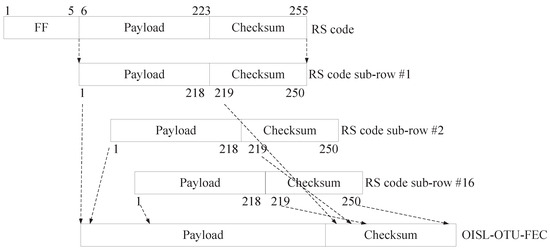
Figure 3.
Schematic diagram of 16-sub-row RS coding.

Figure 4.
Interleaving of RS-encoded symbols.
The uncorrectable bit error rate (effective bit error rate) after interleaving and RS(255,223) encoding is given by [22]
where t denotes the maximum number of errors that the RS code can correct (error correction capability), D represents the interleaving depth, and is the bit error rate of the original channel (before error correction). The binomial term represents the probability of exactly i errors occurring in an interleaved block (containing D symbols).
Each symbol of RS is an element of , and a specific basis can be chosen to represent each symbol. Specifically, the following hold@
- 1.
- The first basis is , such that any symbol can be expressed as
- 2.
- The second basis is , where . On this basis, there exists a dual basis with the following characteristics:where is defined asThen each symbol of the RS can be expressed as
The dual-base method is adopted, where 8 bits represent , and the transmission sequence starts with . The two bases are converted using the formulas in Equation (6) and (7), respectively:
To illustrate the conversion relationship between codes, for a given information symbol I,
Given the check symbol , and ,
For the proposed RS(255,223) encoding, the FEC overhead efficiency is defined as follows [23]:
where is the source rate, is the code rate (, k: information bits, n: coding bits), and is the target bit error rate (), and deep space communication requires . is the channel degradation factor, which characterizes the channel dynamics caused by Doppler frequency shift or atmospheric turbulence, etc., and is defined as .
2.2.3. IP over OISL-OSU
For OSU-carried packet traffic, the fundamental application requirement is MAC transparent transmission. The maximum bit rate of a packet only needs to consider the nominal Ethernet MAC bit rate, which is the maximum assured bandwidth that the packet can deliver. An OSU-carried packet is suitable for carrying Ethernet traffic without a defined bit rate. The bit rate of the packet fluctuates with traffic changes, ranging from 4 to C times the PB benchmark bit rate (). represents the maximum bit rate of the packet, where C refers to the maximum guaranteed bandwidth offered by the packet connection for Ethernet traffic. The maximum OSU bit rate () and the maximum payload bit rate of the OSU () for typical Ethernet services are listed in Table 3 [24].

Table 3.
OSU bit rate and payload bit rate for typical Ethernet service rates.
2.2.4. Comparison of OISL-OSU and OISL-MPLS Technologies
Table 4 displays the comparative analysis of OISL-OSU and OISL-MPLS. Since OISL-OSU implements hard-channel isolation, a stringent resource isolation mechanism ensures the exclusive transmission of service flows via fixed resource reservation (PBs) within the OPU. Thus, OISL-OSU eliminates the need for services to compete for resources, thereby reducing transmission jitter.

Table 4.
Pros and cons of OISL-OSU and OISL-MPLS.
3. Analysis and Discussion
3.1. Experiment Setup
The topology of the satellite optical network used for verification is illustrated in Figure 5. The network topology follows the Beidou System Constellation, consisting of inclined geosynchronous orbit (IGSO), medium earth orbit (MEO), and LEO satellites. For simulation convenience, a simplified network consisting of thirty-eight nodes—comprising the space segment, ground segment, and user segment—is selected [25]. Specifically, the space segment includes thirty-five satellites, i.e., three IGSOs, eleven MEOs, and twenty-one LEOs, while the ground segment and user segment consist of three ground gateway nodes and user terminals, respectively. At least two inter-satellite laser links connect neighboring satellite nodes within the same orbit and between cross-orbit satellite nodes (e.g., IGSO01 and MEO01, and MEO2 and LEO01). These inter-satellite laser links are bi-directional full-duplex links. Additionally, ground gateway stations connect to IGSO and LEO satellites via laser links (e.g., GroundStation01 to IGSO01, and GroundStation01 to LEO04), with each laser link providing a bandwidth of 10.709 Gbps. To simplify the experimental setup, SubMiniature version A (SMA) differential cables were substituted for the wireless laser terminal in the hardware-in-the-loop simulation to emulate the inter-satellite link.
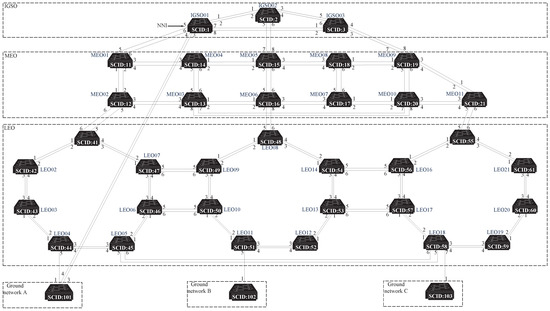
Figure 5.
Satellite optical network topology.
To bridge the theoretical models described above with practical implementation, we further designed a hardware-in-the-loop simulation platform. In Figure 5, nodes spacecraft identifier (SCID) 1, SCID 2, and SCID 101 are selected from the IGSO and ground station nodes as real nodes for hardware-in-the-loop simulation, and the simulation network topology and experiment setup are shown in Figure 6a and Figure 6b, respectively. The device manufacturers and models are listed in Table 5. The hardware-in-the-loop simulation software environment and hardware setups are shown in Table 6. Given that the OISL-OSU interface’s line rate is approximately 10.709 Gbps, the FPGAs used for Switch SCIDs are XILINX 7V690T, which support a maximum serializer–deserializer (GTH) line rate of 12.0 Gbps.
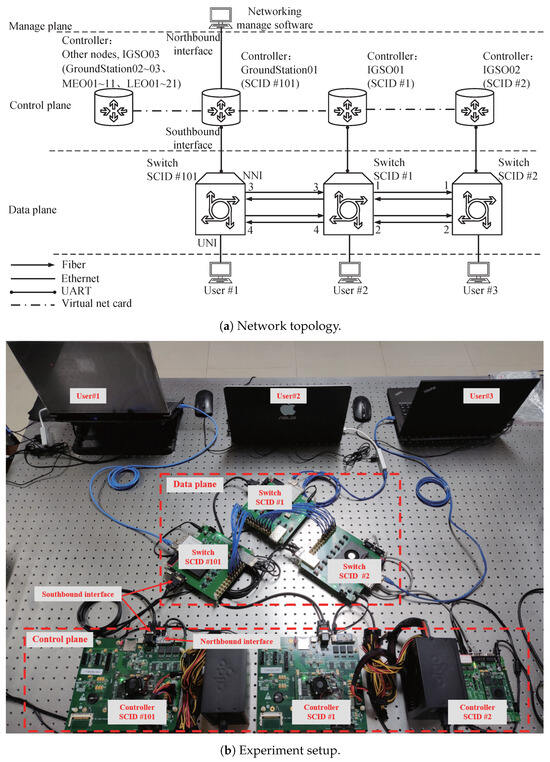
Figure 6.
Semi-physical simulation.

Table 5.
Device manufacturers and models.

Table 6.
Simulation software and hardware setups.
3.2. The Performance of OISL-MPLS
To demonstrate OISL-MPLS switching, the IP capture tool Wireshark and the integrated logic analyzer (ILA) XILINX VIVADO (version 2022.1) are utilized to probe the IP data, in/out-labels, and in/out-ports of OISL-MPLS frames, as illustrated in Figure 7. Figure 7a depicts the IPv6 data transmitted from the source end and received at the destination end, as captured by Wireshark. Figure 7b illustrates the encapsulation of IPv6 data within the Transfer frame data field of the OISL-MPLS frame in SCID #101. This frame is pushed with an out-label (i.e., 0x00D2) and forwarding equivalence class corresponding to the destination IPv6 address FE80::0:0:30::, and it is sent out of port #3 (ingress LER) of node SCID #101 according to the forwarding information base (FIB). Upon receiving the OISL-MPLS frame with an in-label (i.e., 0x00D2), node SCID #1 immediately swaps the in-label (i.e., 0x00D2) to the out-label (i.e., 0xFFFF, since node SCID #1 is the penultimate node in the forward label switching path (LSP)) and forwards the swapped OISL-MPLS frame to port #1 based on the label forwarding information base (LFIB), as shown in Figure 7c. Finally, when node SCID #2 (egress LER) receives the OISL-MPLS frame with an in-label (i.e., 0xFFFF), it pops the in-label, de-encapsulates the IPv6 data from the Transfer frame data field, and delivers the IPv6 data to the terminal User #3, as depicted in Figure 7d. The process for the backward LSP follows a similar mechanism. Table 7 summarizes the in/out-label and in/out-port configurations for the bi-directional OISL-MPLS frame-switching process.
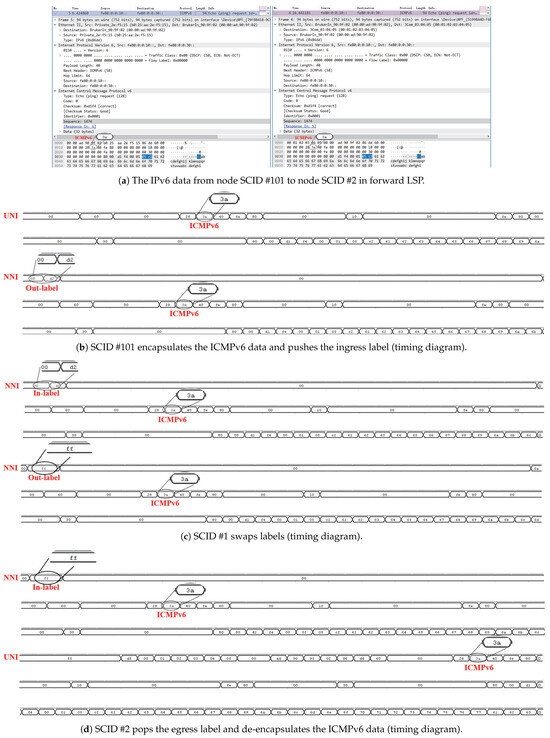
Figure 7.
OISL-MPLS end-to-end testing.

Table 7.
The bi-directional LSP between node SCID #101, node SCID #1, and node SCID #2.
3.3. The Performance of OISL-OSU
The mapping procedure for IP traffic over OISL-OSU is depicted in Figure 8, wherein IPv6 data (ICMPv6) are mapping into the payload of the ODU (as shown in Figure 8a). The ODU frame is then multiplexed to the OTU frame, with the OTU overhead (i.e., 0xF6F6F6282828), as illustrated in Figure 8b.

Figure 8.
OISL-OTU frame.
Moreover, the OISL-OTN-FEC frame encoding process is presented in Figure 9. Given that VIVADO RS encoder/decoder intellectual property cores only support an 8-bit data bit width, while the data bit width of the OISL-OTN-FEC frame is 64 bits, eight RS encoder/decoder intellectual property cores are simultaneously instantiated for processing the frame payload and frame checksum (as shown in Figure 9a and Figure 9b, respectively).


Figure 9.
OISL-OTU-FEC frame.
3.4. Performance Comparison Between OISL-OSU and OISL-MPLS
The performance of OISL-OSU and OISL-MPLS was evaluated based on the Internet Engineering Task Force (IETF) request for comments 2544 (RFC2544) standard under a packet loss rate of 0% [26]. The test results were measured by using an Ethernet tester (MTS 5800, VIAVI Solutions Inc., Chandler, AZ, USA) for throughput, loop delay, packet jitter, and back-to-back performance, as shown in Figure 10, Figure 11, Figure 12, and Figure 13, respectively.
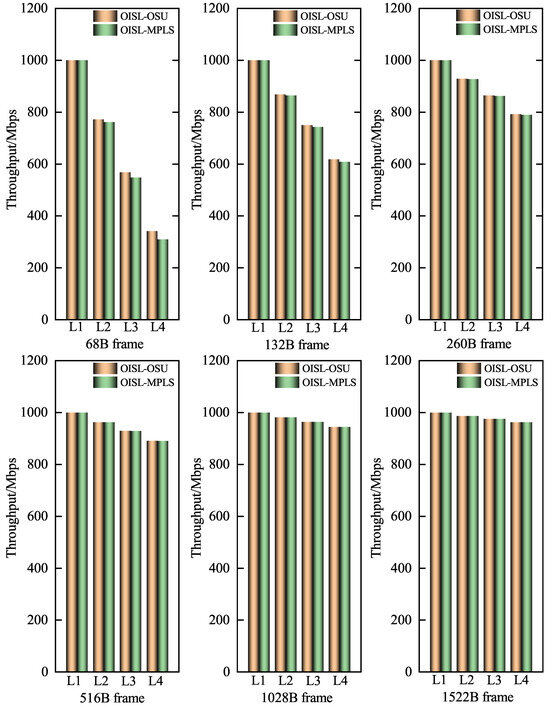
Figure 10.
Throughput test results.
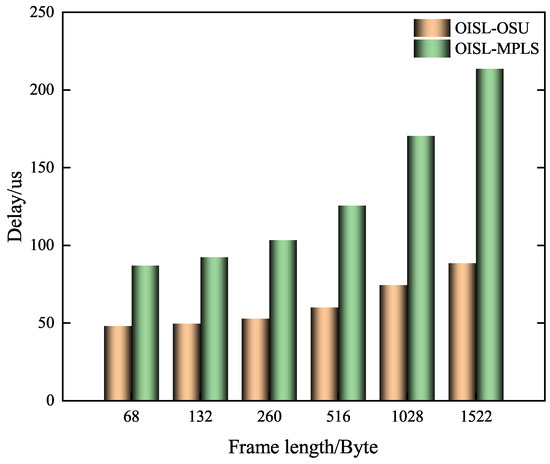
Figure 11.
Round-trip delay test results.
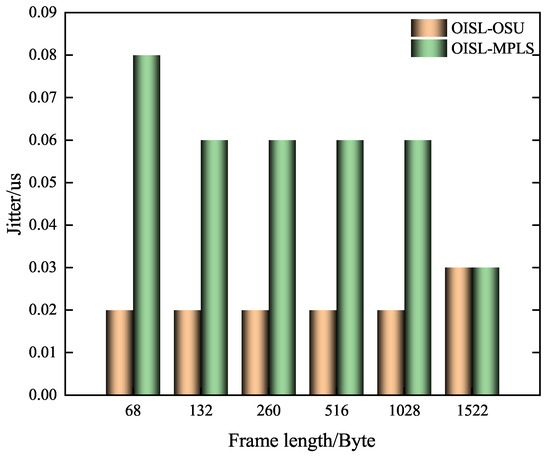
Figure 12.
Jitter test results.
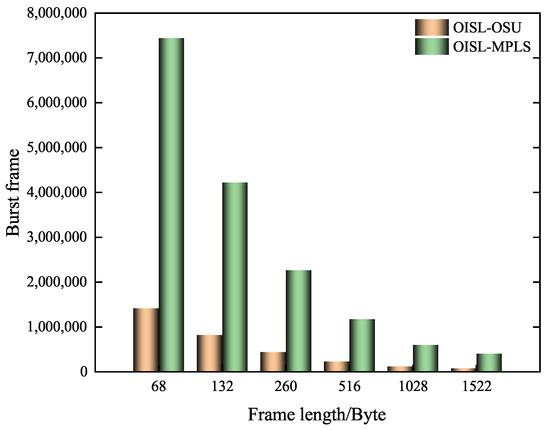
Figure 13.
Back-to-back test results.
The hierarchical evaluation framework in RFC2544 throughput testing exhibits distinct operational characteristics across Open Systems Interconnection (OSI) layers, as systematically demonstrated through controlled experimentation [27]. At Layer 1 (L1, i.e., the physical layer), raw bit rate quantification excludes protocol overhead through the computational model as follows:
where denotes frames per second and represents bits per frame. Electrical signal synchronization was rigorously maintained using precision clock recovery circuits (0.1 ppm stability) during measurement.
At layer 2 (L2, i.e., the data link layer), constituting the RFC2544 baseline implementation, frame forwarding efficiency is demonstrated as follows:
which incorporates inter-packet gap compensation as defined in Institute of Electrical and Electronics Engineers (IEEE) 802.3 specifications [28]. Our experimental configuration maintained 68B to 1522B VLAN frame sizes with measurement tolerance.
Layer 3 (L3, i.e., the network layer) evaluation necessitated IP stack parameter optimization, particularly maximum transmission unit (MTU) configuration, with throughput calculated as
where denotes packets per second and is empirically determined through path MTU discovery algorithms.
Layer 4 (L4, i.e., the transport layer) analysis implemented transmission control protocol (TCP) window scaling (RFC7323) and selective acknowledgment (RFC2018) mechanisms, measuring application-layer data unit transmission efficiency under varied congestion control regimes [29,30].
Firstly, Figure 10 demonstrates that OISL-OSU facilitates flexible bandwidth distribution, ranging from 2 Mbps to 1000 Mbps, and can dynamically adapt to operational demands. Both OISL-OSU and OISL-MPLS achieve high bandwidth utilization (with L1 rates ranging from 999.96 Mbps to 999.97 Mbps and 999.99 Mbps to 1000.00 Mbps, respectively). Notably, OISL-OSU outperforms OISL-MPLS in terms of bandwidth utilization when carrying small-packet services (frame lengths ranging from 68B to 132B). The throughput of OISL-MPLS depends on the network’s bandwidth configuration and traffic management strategy, constrained by packet switching efficiency and network congestion.
On the other hand, Figure 11 illustrates the loop delay performance. OISL-OSU adopts a flexible time-slot multiplexing mechanism, which eliminates the necessity for fixed data caching at intermediate nodes, thereby substantially reducing single-node delay. By optimizing the encapsulation layer, OISL-OSU significantly decreases both encapsulation and cross-processing latencies. Compared with OISL-MPLS, OISL-OSU reduces single-node delay by 44.72%, 46.26%, 48.78%, 52.11%, 56.29%, and 58.58% for frame lengths ranging from 68B to 1522B, respectively. These results demonstrate that OISL-OSU is well-suited for time-sensitive business scenarios.
Furthermore, Figure 12 shows the packet jitter performance. OISL-OSU provides a hard channel with predictable delays, effectively reducing packet jitter and making it suitable for delay-sensitive services. Packet jitter in OISL-MPLS is influenced by network congestion and traffic scheduling. As depicted in Figure 12, compared with OISL-MPLS, OISL-OSU reduces jitter by 75.00%, 66.67%, 66.67%, 66.67%, 66.67%, and 0% for frame lengths ranging from 68B to 1522B, respectively.
Finally, Figure 13 displays the back-to-back performance. Compared with OISL-MPLS, OISL-OSU reduces average burst frames by 80.91%, 80.53%, 80.29%, 80.15%, 80.08%, and 80.05% for frame lengths ranging from 68B to 1522B, respectively. The experimental data indicate that OISL-OSU outperforms OISL-MPLS in terms of bandwidth utilization, delay, jitter, and reliability.
3.5. Performance Evaluation
Following the analysis of delay performance, we have conducted a quantitative evaluation of the delay optimization mechanism of OISL-OSU compared with OISL-MPLS from three perspectives: network architecture, protocol processing, and switching mode.
- 1.
- Network architectureTable 8 presents a comparative overview of the network architectures of OISL-OSU and OISL-MPLS.
 Table 8. Network architecture delay comparison.
Table 8. Network architecture delay comparison. - 2.
- Protocol processingThe OISL-MPLS protocol stack processing delay comprises IP/Label header processing (), forwarding table lookup (), and QoS shaping (), which isMeanwhile the OISL-OSU protocol processing delay is burst scheduling ():
- 3.
- Switching modeStore-and-forward processing ( and ) contributes to the delay in OISL-MPLS packet switching, which isIn contrast, OISL-OSU ensures deterministic delay through pre-configured optical paths () and implements cacheless forwarding based on burst header packets () as follows:
4. Conclusions
The proposed OISL-OSU method provides an effective solution to the bottleneck of carrying small-granularity, high-quality dedicated line services in current satellite optical networks. The comparison test results demonstrates that OISL-OSU outperforms OISL-MPLS in terms of bandwidth utilization, delay, jitter, and burst processing capabilities. The hard-channel, deterministic delay, and high reliability characteristics of OISL-OSU align with the stringent requirements of 6G networks for space–terrene–sea integration and industrial Internet. OISL-OSU can be applied in specialized scenarios such as high-frequency financial trading (microsecond-level delay-sensitive), industrial automation (with deterministic delay requirements), and ultra-high-definition video transmission (ensuring smoothness with low jitter), and is expected to become one of the core transmission technologies in 6G networks.
Author Contributions
Conceptualization, W.Z. and Q.L.; methodology, W.Z. and B.C.; software, W.Z. and B.C.; hardware, W.Z. and B.P.; validation, W.Z. and B.G.; writing—original draft preparation, W.Z.; writing—review and editing, B.G.; supervision, Q.L.; project administration, W.Z. All authors have read and agreed to the published version of the manuscript.
Funding
This research was fully funded by the 2024 Guangxi Key R&D Program Project (Grant No. GuiKe AB24010272, Approval No. 2023AB07026) and Development Fund Project of the 34th Institute of China Electronics Science and Technology Group Corporation in 2022 (Grant No. K134002022S702).
Institutional Review Board Statement
Not applicable.
Informed Consent Statement
Not applicable.
Data Availability Statement
The original contributions presented in this study are included in the article. Further inquiries can be directed to the corresponding author.
Conflicts of Interest
The authors declare that they have no known competing financial interests or personal relationships that could have appeared to influence the work reported in this paper. Wei Zhou, Qingsong Luo, and Boying Cao are employees of The 34th Research Institute of China Electronics Technology Group Corporation. The authors declare that this study received funding from The 34th Research Institute of China Electronics Technology Group Corporation. The funder had no role in the design of the study; in the collection, analysis, or interpretation of data; in the writing of the manuscript; or in the decision to publish the results.
Abbreviations
The following abbreviations are used in this manuscript:
| AOSs | Advanced orbiting systems |
| CCSA | China Communications Standards Association |
| CCSDS | Consultative Committee for Space Data Systems |
| CETC | China Electronics Technology Group Corporation |
| DCN | Data communication network |
| DDPG | Depth deterministic policy gradient |
| DRL | Deep reinforcement learning |
| FEC | Forward error correction |
| FIB | Forwarding information base |
| FIFO | First-in-first-out |
| Gbps | Gigabits per second |
| GE | Gigabit Ethernet |
| GNNs | Graph neural networks |
| IEEE | Institute of Electrical and Electronics Engineers |
| IETF | Internet Engineering Task Force |
| IGSO | Inclined geosynchronous orbit |
| IP | Internet protocol |
| ILA | Integrated logic analyzer |
| ITU-T | International Telecommunication Union—Telecommunication |
| Standardization Sector | |
| LEO | Low earth orbit |
| LER | Label edge router |
| LFIB | Label forwarding information base |
| LSP | Label switching path |
| LSR | Label switching router |
| M-OTN | Metro-optimized optical transport network |
| MAC | Media access control |
| Mbps | Megabits per second |
| MEO | Medium earth orbit |
| MPLS | Multi-protocol label switching |
| MTU | Maximum transmission unit |
| NNI | Network to network interface |
| ODU | Optical channel data unit |
| OISL-OSU | Optical inter-satellite links based on optical service unit |
| OPU | Optical channel payload unit |
| OSI | Open Systems Interconnection |
| OSTU | Optical service branch unit |
| OSU | Optical service unit |
| OTN | Optical transport networks |
| OTU | Optical channel transport unit |
| PB | Payload block |
| PHY | Physical layer |
| QoS | Quality-of-service |
| RFC | Request for comments |
| RS | Reed–Solomon |
| SCID | Spacecraft identifier |
| SMA | SubMiniature version A |
| TCP | Transmission control protocol |
| TPN | Tributary port number |
| VLAN | Virtual local area network |
| XGE | 10 Gigabit Ethernet |
| XGMII | 10 Gigabit media-independent interface |
References
- State Council of the People’s Republic of China. The 14th Five-Year Plan for Digital Economy Development of the People’s Republic of China. Technical Report. 2021. Available online: https://www.gov.cn/zhengce/zhengceku/2022-01/12/content_5667817.htm (accessed on 23 April 2025).
- Park, E.A.; Cornwell, D.; Israel, D. NASA’s next generation ≥ 100 Gbps optical communications relay. In Proceedings of the 2019 IEEE Aerospace Conference, Big Sky, MT, USA, 2–9 March 2019; pp. 1–9. [Google Scholar]
- Schieler, C.M.; Riesing, K.M.; Bilyeu, B.C.; Robinson, B.S.; Wang, J.P.; Roberts, W.T.; Piazzolla, S. TBIRD 200-Gbps CubeSat downlink: System architecture and mission plan. In Proceedings of the 2022 IEEE International Conference on Space Optical Systems and Applications (ICSOS), Kyoto City, Japan, 29–31 March 2022; pp. 181–185. [Google Scholar]
- Jing, R.; Zhang, C.; Zhou, H.; Li, J.; Qiuyou, W.; Zhang, Y.; Wang, Y.; Su, W.; Gong, Y.; Huo, X. Innovation and demonstration of optical service unit-based metro-optimized OTN technologies. J. Opt. Commun. Netw. 2022, 14, 236–247. [Google Scholar] [CrossRef]
- Jing, R.; Shen, L.; Jin, Z.; Zhang, J.; Yao, Y.; Cheng, L.; Zhou, H. Network model of M-OTN based on OSU and experiment in real network. Telecommun. Sci. 2023, 39, 139–148. [Google Scholar]
- Industry Standard YD/T 4855-2024; Technical Requirements for Optical Service Unit (OSU): YD/T 4855-2024. China Communications Standards Association: Beijing, China, 2024.
- Chao, F.; Jing, R. Research on Government-Enterprise OTN Network Architecture and Service Model Based on OSU Technology. Study Opt. Commun. 2024, 1–10. Available online: https://link.cnki.net/urlid/42.1266.TN.20241011.1111.004 (accessed on 8 April 2025).
- Tan, Y.; Duan, Z.; Man, X.; Zhang, H.; Liu, Y.; Zhou, Y.; Dong, S. Research on Intelligent Management and Control Technology of OTN Based on OSU. Telecommun. Sci. 2023, 39, 147–155. [Google Scholar]
- Jing, Y.; Jiang, C.; Zhan, Y. 6G Integrated Communication, Sensing, and Computing Architecture for Satellite Communications: Technologies and Challenges. Radio Commun. Technol. 2023, 49, 12–20. [Google Scholar]
- Endla, P.; Pure, R.S.; Soni, A.; Andal, C.; Jagadeeswari, D.; Devi, K.N. Intelligent 5G Evolution: AI-Augmented Hybrid Model with Network Slicing and Autonomous Self-Healing for Future-Ready Connectivity. In Proceedings of the 2025 International Conference on Electronics and Renewable Systems (ICEARS), Thoothukudi, India, 11–13 February 2025; pp. 839–846. [Google Scholar]
- Zhou, W.; Luo, Q.; Xie, X.; Jing, C.; Cheng, X.; Pan, B. Integrated Satellite Routing Optimization Algorithm Based on OISL-OSU. Opt. Commun. Technol. 2024, 48, 51–59. [Google Scholar]
- Roth, M.; Brandt, H.; Bischl, H. Implementation of a geographical routing scheme for low Earth orbiting satellite constellations using intersatellite links. Int. J. Satell. Commun. Netw. 2021, 39, 92–107. [Google Scholar] [CrossRef]
- Hu, M.; Li, J.; Cai, C.; Deng, T.; Xu, W.; Dong, Y. Software defined multicast for large-scale multi-layer leo satellite networks. IEEE Trans. Netw. Serv. Manag. 2022, 19, 2119–2130. [Google Scholar] [CrossRef]
- Hu, M.; Yang, R.; Hu, Y.; Cai, C.; Dong, Y.; Deng, T.; Peng, K. Qos-aware software-defined multicast in leo satellite networks. IEEE Trans. Aerosp. Electron. Syst. 2022, 58, 5307–5317. [Google Scholar] [CrossRef]
- Schieler, C.; Robinson, B.; Guldner, O.; Bilyeu, B.; Garg, A.; Riesing, K.; Chang, J.; Hakimi, F.; Brown, J.; Khatri, F.; et al. NASA’s Terabyte Infrared Delivery (TBIRD) Program: Large-Volume Data Transfer from LEO; Utah State University: Logan, UT, USA, 2019. [Google Scholar]
- Ravel, K.; Koechlin, C.; Prevost, E.; Bomer, T.; Poirier, R.; Tonck, L.; Guinde, G.; Beaumel, M.; Parsons, N.; Enrico, M.; et al. Optical switch matrix development for new concepts of photonic based flexible telecom payloads. In Proceedings of the International Conference on Space Optics—ICSO 2018, Chania, Greece, 9–12 October 2019; Volume 11180, pp. 1319–1332. [Google Scholar]
- Alatwi, A.M.; Rashed, A.N.Z.; El-Gammal, E.M. Wavelength division multiplexing techniques based on multi transceiver in low earth orbit intersatellite systems. J. Opt. Commun. 2024, 45, 125–135. [Google Scholar] [CrossRef]
- Sun, X.; Cao, S. A routing and wavelength assignment algorithm based on two types of LEO constellations in optical satellite networks. J. Light. Technol. 2020, 38, 2106–2113. [Google Scholar] [CrossRef]
- Consultative Committee for Space Data Systems. IP over CCSDS Space Links; Blue Book CCSDS 702.1-B-1; CCSDS: Washington, DC, USA, 2012; Available online: https://ccsds.org/Pubs/702x1b1c2.pdf (accessed on 16 April 2025).
- ITU-T Study Group 15. Architecture for the Automatically Switched Optical Network; Recommendation G.8080; International Telecommunication Union: Geneva, Switzerland, 2012; Available online: https://www.itu.int/ITU-T/recommendations/rec.aspx?rec=G.8080 (accessed on 21 March 2025).
- ITU-T. Interfaces for the Optical Transport Network; Recommendation G.709/Y.1331; International Telecommunication Union: Geneva, Switzerland, 2016; Available online: https://www.itu.int/rec/T-REC-G.709 (accessed on 14 February 2025).
- Lin, S.; Costello, D.J. Error Control Coding; Prentice Hall Scarborough: Englewood Cliffs, NJ, USA, 2001; Volume 2. [Google Scholar]
- Consultative Committee for Space Data Systems. CCSDS 131.2-B-2: Flexible Advanced Coding and Modulation Scheme for High Rate Telemetry Applications. Technical Report. CCSDS. 2023. Available online: https://ccsds.org/Pubs/131x2b2.pdf (accessed on 12 January 2025).
- Standard YD/T 4855-2024; Technical Requirements for Optical Service Unit (OSU). Ministry of Industry and Information Technology of the People’s Republic of China: Beijing, China, 2024.
- China Satellite Navigation Office. Introduction to BeiDou Navigation Satellite System. Technical Report. 2017. Available online: http://www.beidou.gov.cn/xt/xtjs/201710/t20171011_280.html (accessed on 15 March 2025).
- Mogul, J.; Deering, S.; Waitzman, D.; Fenner, B. RFC 2544: Benchmarking Methodology for Network Interconnect Devices. Request for Comments 2544. Internet Engineering Task Force. 1999. Available online: https://tools.ietf.org/html/rfc2544 (accessed on 18 April 2025).
- ISO/IEC JTC 1/SC 6; Information Technology—Open Systems Interconnection—Basic Reference Model—Amendment 1: Quantum-Secure Communication Framework. International Standard Amendment ISO/IEC 7498-1:1994/Amd 1:2022; International Organization for Standardization: Geneva, Switzerland, 2022. Available online: https://www.iso.org/standard/82321.html (accessed on 6 March 2025).
- IEEE Std 802.3-2022; IEEE Standard for Ethernet. Institute of Electrical and Electronics Engineers: Piscataway, NJ, USA, 2022. Available online: https://ieeexplore.ieee.org/document/9844436 (accessed on 17 March 2025).
- Borman, D.; Braden, B.; Jacobson, V.; Scheffenegger, R. TCP Extensions for High Performance. Request for Comments 7323. Internet Engineering Task Force. 2014. Available online: https://tools.ietf.org/html/rfc7323 (accessed on 4 February 2025).
- Mathis, M.; Mahdavi, J.; Floyd, S.; Romanow, A. TCP Selective Acknowledgment Options. Request for Comments 2018. Internet Engineering Task Force. 1996. Available online: https://tools.ietf.org/html/rfc2018 (accessed on 16 January 2025).
Disclaimer/Publisher’s Note: The statements, opinions and data contained in all publications are solely those of the individual author(s) and contributor(s) and not of MDPI and/or the editor(s). MDPI and/or the editor(s) disclaim responsibility for any injury to people or property resulting from any ideas, methods, instructions or products referred to in the content. |
© 2025 by the authors. Licensee MDPI, Basel, Switzerland. This article is an open access article distributed under the terms and conditions of the Creative Commons Attribution (CC BY) license (https://creativecommons.org/licenses/by/4.0/).